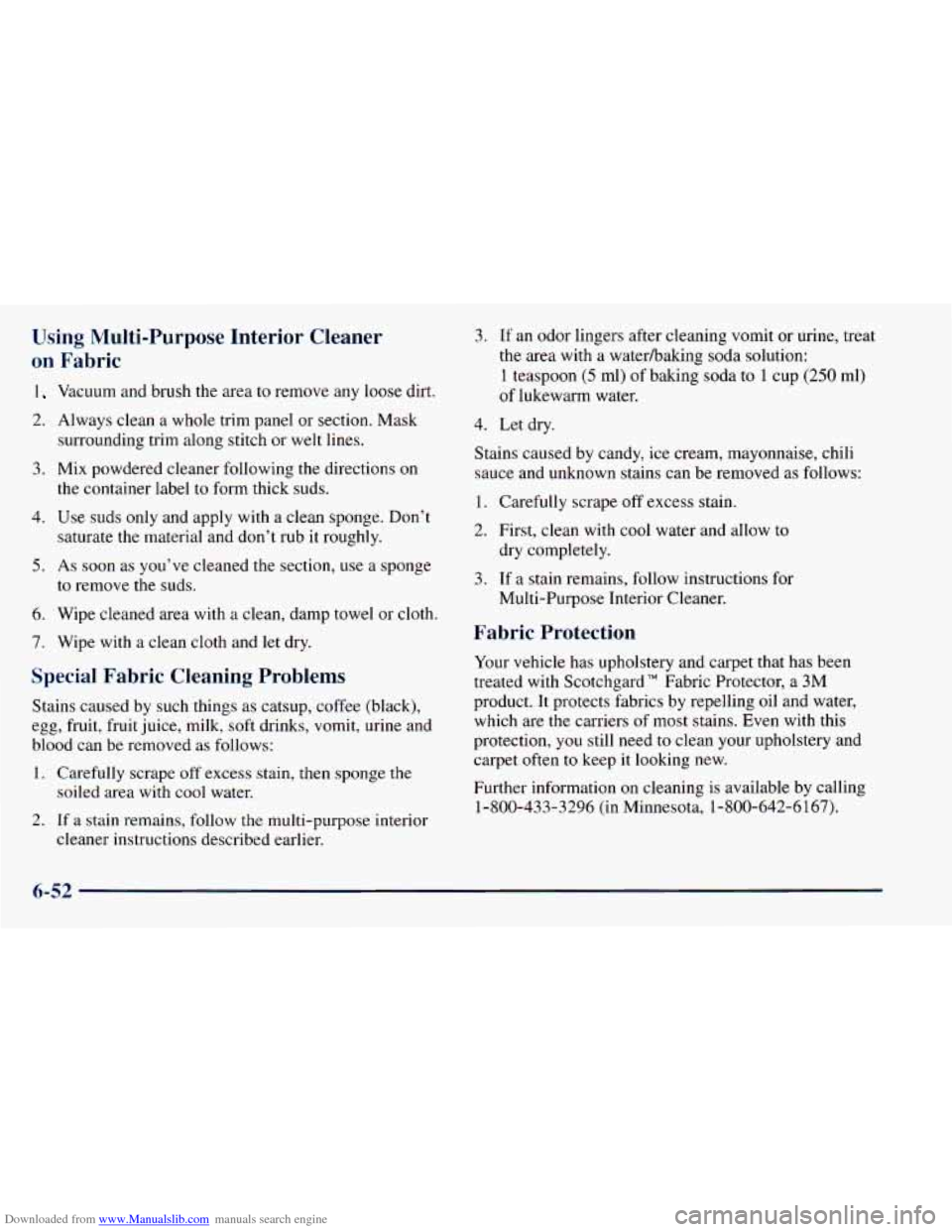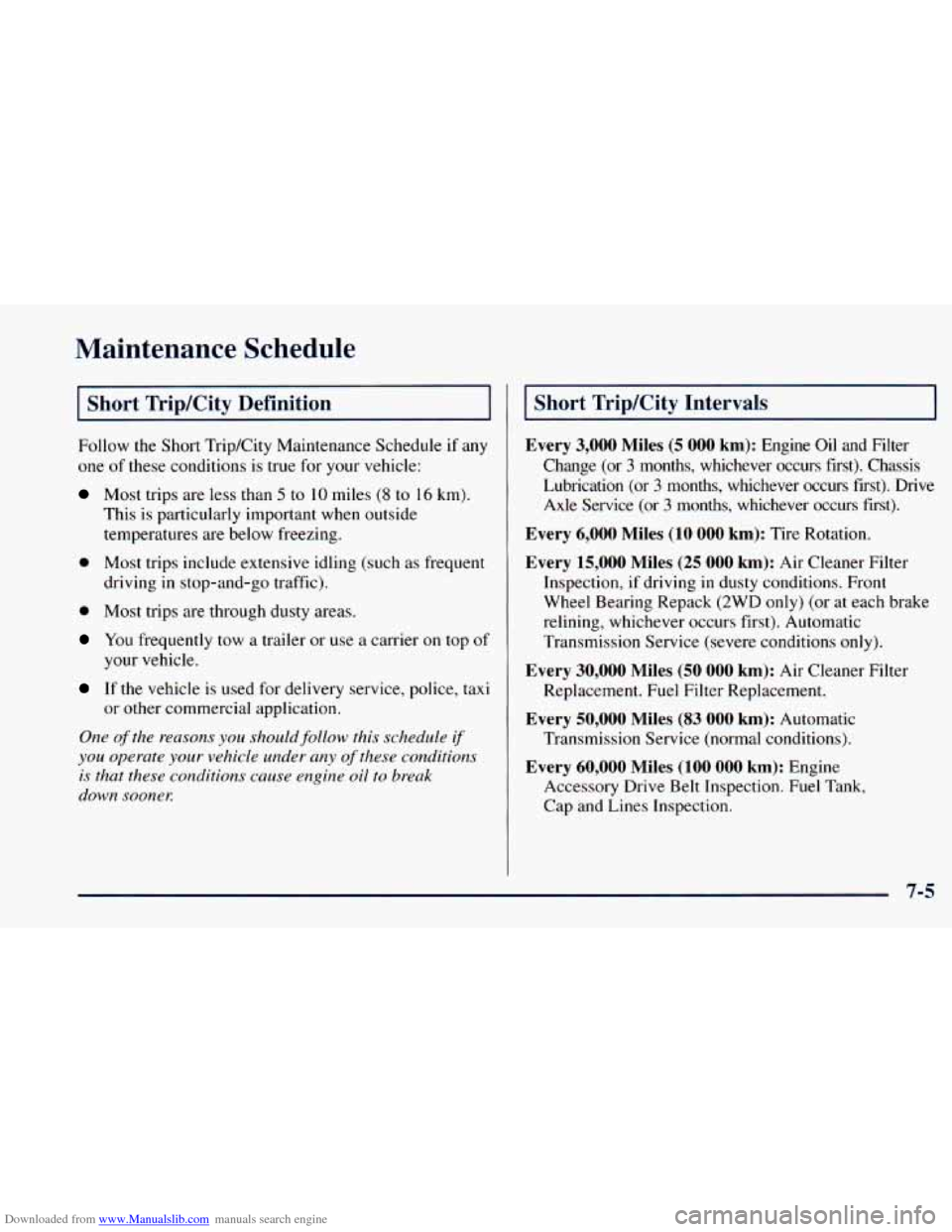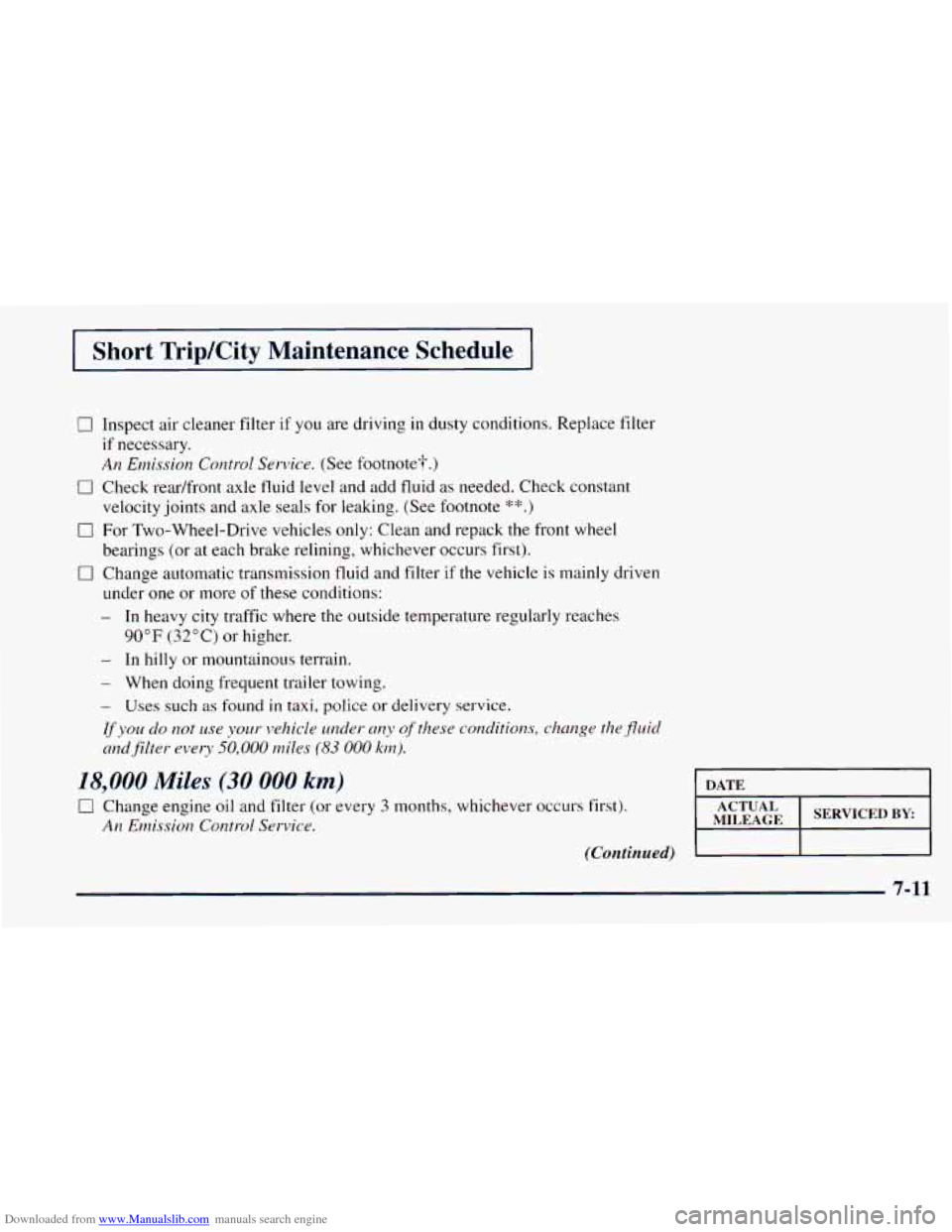tow CHEVROLET ASTRO 1998 2.G Repair Manual
[x] Cancel search | Manufacturer: CHEVROLET, Model Year: 1998, Model line: ASTRO, Model: CHEVROLET ASTRO 1998 2.GPages: 414, PDF Size: 21.46 MB
Page 302 of 414

Downloaded from www.Manualslib.com manuals search engine 6. Remove the composite
assembly.
7. Turn the halogen bulb
toward the left
to
remove from
the assembly.
8. Install the new bulb into the composite assembly
by turning it toward the right until it is
completely tightened.
tightening all
of the screws previously removed.
9. Replace the composite assembly by installing and
Front Turn Signal Lamps
1. Remove the two screws at the inside edge of the
parkingkurn signal lamp assembly.
4.
5.
6.
7.
8.
.. .
2.
3.
Remove the lamp
assembly.
Squeeze the tab
on the
side of the lamp socket
while turning the socket
toward
the left.
Pull the socket out
of the lamp assembly.
Pull the bulb from the socket.
Gently push the new bulb into the socket.
Put the socket back into the lamp assembly and turn
it toward the right until it locks.
Put
the parkinghrn signal lamp assembly back into
the vehicle and tighten the screws.
6-40
Page 307 of 414

Downloaded from www.Manualslib.com manuals search engine I
Don’t include the compact spare tire in your
tire rotation.
After the tires have been rotated, adjust the front and
rear inflation pressures as shown on the
Certificationire label. Make certain that all wheel nuts
are properly tightened. See “Wheel Nut Torque” in
the Index.
Rust or dirt on a wheel, or on the parts to which
it
is fastened, can make wheel nuts become loose
after
a time. The wheel could come off and cause
an accident. When you change
a wheel, remove
any rust or dirt from places where the wheel
attaches to the vehicle.
In an emergency, you can
use
a cloth or a paper towel to do this; but be
sure to use
a scraper or wire brush later, if you
need to, to get all the rust or dirt
off. (See
“Changing
a Flat Tire” in the Index.) When
It’s Time for New Tires
One way to tell when it’s
time for new tires is to
check the treadwear
indicators, which will
appear when your tires have
only
1/16 inch (1.6 mm) or
less of tread remaining.
You need a new tire if any of the following statements
are true:
0 You can see the indicators at three or more places
around the tire.
0 YOU can see cord or fabric showing through the
tire’s rubber.
The tread or sidewall is cracked, cut or snagged deep
enough to show cord or fabric.
0 The tire has a bump, bulge or split.
0 The tire has a puncture, cut or other damage that
can’t be repaired well because of the size or location
of the damage.
6-45
Page 314 of 414

Downloaded from www.Manualslib.com manuals search engine Using Multi-Purpose Interior C1f ~ ~ ~ r
on Fabric
I Vacuum and brush the area to remove any loose dirt.
2. Always clean a whole trim panel or section. Mask
3. Mix powdered cleaner following the directions on
surrounding trim along stitch or welt lines.
the container label to form thick suds.
4. Use suds only and apply with a clean sponge. Don't
5. As soon as you've cleaned the section, use a sponge
saturate
the material and
don't rub it roughly.
to remove the suds.
6. Wipe cleaned area with a clean, damp towel or cloth.
7. Wipe with a clean cloth and let dry.
Special Fabric Cleaning Problems
Stains caused by such things as catsup, coffee (black),
egg, fruit, fruit juice, milk, soft drinks, vomit, urine and
blood can be removed as follows:
1. Carefully scrape off excess stain, then sponge the
soiled area with cool water.
2. If a stain remains, follow the multi-purpose interior
cleaner instructions described earlier.
3. If an odor lingers after cleaning vomit or urine, treat
the area with a waterhaking soda solution:
1 teaspoon (5 ml) of baking soda to 1 cup (250 ml)
of lukewarm water.
4. Let dry.
Stains caused by candy, ice cream, mayonnaise, chili
sauce and unknown stains can be removed as follows:
1. Carefully scrape off excess stain.
2. First, clean with cool water and allow to
dry completely.
3. If a stain remains, follow instructions for
Multi-Purpose Interior Cleaner.
Fabric Protection
Your vehicle has upholstery and carpet that has been
treated with Scotchgard" Fabric Protector, a
3M
product. It protects fabrics by repelling oil and water,
which are the carriers
of most stains. Even with this
protection, you still need
to clean your upholstery and
carpet often to keep it looking new.
Further information on cleaning is available by calling
1-800-433-3296
(in Minnesota, 1-800-642-6167).
6-52
Page 317 of 414

Downloaded from www.Manualslib.com manuals search engine Weatherstrips
Silicone grease on weatherstrips will make them last
longer, seal better, and not stick or squeak. Apply
silicone grease with a clean cloth at least every
six months. During very cold, damp weather more
frequent application may be required. (See
“Recommended Fluids and Lubricants” in the Index.)
Cleaning the Outside of Your Vehicle
The paint finish on your vehicle provides beauty, depth
of color, gloss retention and durability.
Washing Your Vehicle
The best way to preserve your vehicle’s finish is to keep \
it
clean by washing it often with lukewarm or cold water.
Don’t wash your vehicle in the direct rays of the sun.
Don’t use strong soaps or chemical detergents. Use
liquid hand, dish or car washing (mild detergent) soaps.
You can get GM-approved cleaning products from your
dealer. (See “Appearance Care and Materials” in the
I Index.) Don’t use cleaning agents that are petroleum
based, or that contain acid or abrasives. All cleaning
1 agents should be flushed promptly and not allowed to dry on the surface, or
they could stain. Dry the finish
with a soft, clean chamois or an all-cotton towel to
avoid surface scratches and water spotting.
High pressure car washes may cause water to enter
your vehicle.
Cleaning Exterior LampsLenses
Use lukewarm or cold water, a soft cloth and a liquid
hand, dish or car washing (mild detergent) soap to clean
exterior lamps and lenses. Follow instructions under
“Washing Your Vehicle.”
Finish Care
Occasional waxing or mild polishing of your vehicle by
hand may be necessary to remove residue from the paint
finish. You can get GM-approved cleaning products
from your dealer. (See “Appearance Care and Materials”
in the Index.)
Your vehicle has a “basecoat/clearcoat” paint finish.
The clearcoat gives more depth and gloss to the colored
basecoat. Always use waxes and polishes that are
non-abrasive and made for a basecoatklearcoat
paint finish.
6-55
Page 318 of 414

Downloaded from www.Manualslib.com manuals search engine I NOTICE:
Machine compounding or aggressive polishing on
a basecoat/clearcoat paint finish may dull the
finish or leave swirl marks.
Foreign materials such as calcium chloride and other
salts, ice melting agents, road oil and tar, tree sap, bird
droppings, chemicals from industrial chimneys, etc., can
damage your vehicle’s finish if
they remain on painted
surfaces. Wash the vehicle as soon as possible. If
necessary, use non-abrasive cleaners that are marked
safe for painted surfaces to remove foreign matter.
Exterior painted surfaces are subject to aging, weather
and chemical fallout that can take their
toll over a period
of years. You can help
to keep the paint finish looking
new by keeping your vehicle garaged or covered
whenever possible.
Cleaning Aluminum Wheels
(If Equipped)
Keep your wheels clean using a soft clean cloth with
mild soap and water. Rinse with clean water. After rinsing thoroughly, dry with
a soft clean towel.
A wax
may then be applied.
The surface of these wheels is similar to the painted
surface of your vehicle. Don’t use strong soaps,
chemicals, abrasive polishes, abrasive cleaners or
abrasive cleaning brushes
on them because you could
damage the surface.
Don’t take your vehicle through an automatic car wash
that has silicon carbide tire cleaning brushes. These
brushes can also damage the surface of these wheels.
Cleaning Tires
To clean your tires, use a stiff brush with a tire cleaner.
I NOTICE:
When applying a tire dressing always take care to
wipe
off any overspray or splash from all painted
surfaces on the body or wheels
of the vehicle.
Petroleum-based products may damage the
paint finish.
6-56
Page 326 of 414

Downloaded from www.Manualslib.com manuals search engine Underhood Electrical Center
c
SThRTER ENABLE ENABLE =CLAY
(,,,) (-) (COLI-
I
I
[ LIGHTING 1
(7)
(T)
(-)
(-)
The underhood electrical center is located toward the
rear
of the engine compartment on the driver’s side.
Lift the hood and open
the cover to gain access to this
fuse block.
Feed Usage
AUX B Upfitter Battery Feed
AUX A Upfitter Accessory Feed
Relay
A/C Relay (Rear Heat and A/C)
Upfitter Accessory Relay
Starter Enable Relay
A/C Enable Relay
Export Only Relay
Fuel Pump Relay
6-64
Page 339 of 414

Downloaded from www.Manualslib.com manuals search engine Maintenance Schedule
I Short Trip/City Definition
Follow the Short Trip/City Maintenance Schedule if any
one of these conditions
is true for your vehicle:
Most trips are less than 5 to 10 miles (8 to 16 km).
This is particularly important when outside
temperatures are below freezing.
driving
in stop-and-go traffic).
0 Most trips are through dusty areas.
You frequently tow a trailer or use a carrier on top of
If the vehicle is used for delivery service, police, taxi
One of the reasons you should follow this schedule if
you operate your vehicle under any of these conditions
is that these conditions cause engine oil to
break
down sooneE
0 Most trips include extensive idling (such as frequent
your vehicle.
or other commercial application.
I Short Trip/City Intervals
Every 3,000 Miles (5 000 km): Engine Oil and Filter
Change (or
3 months, whichever occurs first). Chassis
Lubrication (or
3 months, whichever occurs first). Drive
Axle Service (or
3 months, whichever occurs first).
Every 6,000 Miles (10 000 km): Tire Rotation.
Every 15,000 Miles (25 000 km): Air Cleaner Filter
Inspection, if driving
in dusty conditions. Front
Wheel Bearing Repack
(2WD only) (or at each brake
relining, whichever occurs first). Automatic
Transmission Service (severe conditions only).
Every 30,000 Miles (50 000 km): Air Cleaner Filter
Replacement. Fuel Filter Replacement.
Every 50,000 Miles (83 000 km): Automatic
Transmission Service (normal conditions).
Every 60,000 Miles (100 000 km): Engine
Accessory Drive Belt Inspection. Fuel Tank,
Cap and Lines Inspection.
7-5
Page 340 of 414

Downloaded from www.Manualslib.com manuals search engine Maintenance Schedule
I Short Trip/City Intervals
Every 100,000 Miles (166 000 km): Spark Plug Wire
Inspection. Spark Plug Replacement. Positive
Crankcase Ventilation (PCV) Valve Inspection.
Every 150,000 Miles (240 000 km): Cooling System
Service (or every
60 months, whichever occurs first).
These intervals only summarize maintenance services.
Be sure to follow the complete maintenance schedule
on
the following pages.
Long Trip/Highway Definition ,-
Follow this maintenance schedule only if none of the
conditions from the Short TripKity Maintenance
Schedule
is true. Do not use this schedule if the vehicle
is used for trailer towing, driven in a dusty area or used
off paved roads. Use the Short Trip/City schedule for
these conditions.
Driving a vehicle with a fully warmed engine
under higlzway conditions causes engine oil to
break down slowec
c
7-6
Page 342 of 414

Downloaded from www.Manualslib.com manuals search engine Short TripKity Maintenance Schedule
The services shown in this schedule up to 100,000 miles
(166 000 km) should be performed after 100,000 miles
(166 000 km) at the same intervals. The services shown
at 150,000 miles
(240 000 km) should be performed at
the same interval after 150,000 miles (240 000 km).
See “Owner Checks and Services’’ and “Periodic
Maintenance Inspections” following.
Footnotes
The U.S. Envlronmental Protection Agency or the
California Air Resources Board has determined that the
failure to perform this maintenance item will
not nullify
the emission warranty or limit recall liability prior to the
completion
of the vehicle’s useful life. We, however,
urge that all recommended maintenance services be
performed at the indicated intervals and the maintenance
be recorded.
# Lubricate the front suspension, ball joints and kingpin
bushings, steering linkage and transfer case shift linkage,
parking brake cable guides, and brake pedal springs.
+ A good time to check your brakes is during tire
rotation. See “Brake System Inspection” under “Periodic
Maintenance Inspections” in Part
C of this schedule.
** Drive axle service (see “Recommended Fluids and
Lubricants”
in the Index for proper lubricant to use):
0
0
0
Locking Differential -- Drain fluid and refill at first
engine oil change. At subsequent oil changes, check
fluid level and add fluid as needed. If driving
in
dusty areas or towing a trailer, drain fluid and refill
every 15,000 miles
(25 000 km).
Standard Differential
-- Check fluid level and add
fluid as needed at every oil change. If driving in
dusty areas or towing a trailer, drain fluid and refill
every 15,000 miles
(25 000 km).
More frequent lubrication may be required for
heavy-duty use.
7-8
Page 345 of 414

Downloaded from www.Manualslib.com manuals search engine 1 Short TripKity Maintenance Schedule I
0 Inspect air cleaner filter if you are driving in dusty conditions. Replace filter
if necessary.
An Emission Control Service. (See footnote?.)
velocity joints and axle seals for leaking. (See footnote
**.)
bearings (or at each brake relining, whichever occurs first).
under
one or more of these conditions:
0 Check readfront axle fluid level and add fluid as needed. Check constant
0 For Two-Wheel-Drive vehicles only: Clean and repack the front wheel
0 Change automatic transmission fluid and filter if the vehicle is mainly driven
- In heavy city traffic where the outside temperature regularly reaches
- In hilly or mountainous terrain.
- When doing frequent trailer towing.
90 OF (32 O C) or higher.
- Uses such as found in taxi, police or delivery service.
If you do not use yaw- vehicle under any of these conditions, change thejiruid
andfilter every
50,000 miles (83 000 km).
18,000 Miles (30 000 km)
0 Change engine oil and filter (or every 3 months, whichever occurs first).
An Emission Control Service.
7-11